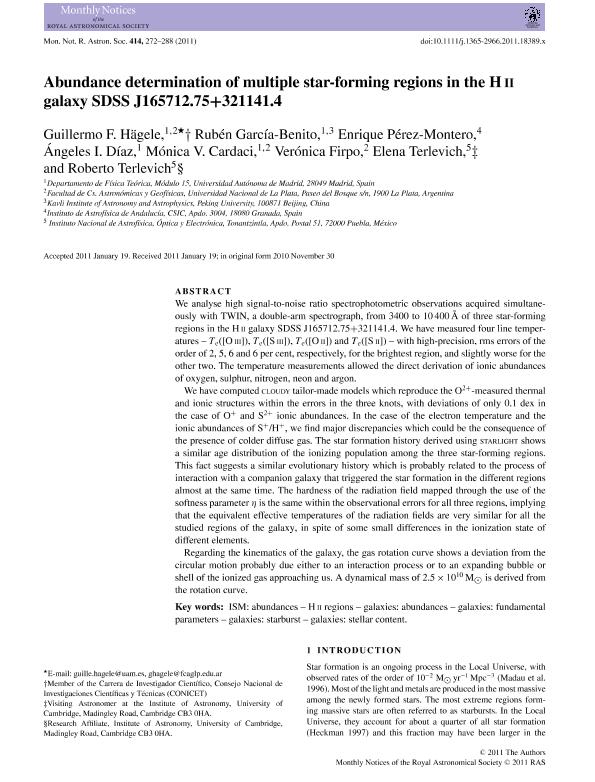Mostrar el registro sencillo del ítem
dc.contributor.author
Hägele, Guillermo Federico

dc.contributor.author
García Benito, Rubén

dc.contributor.author
Pérez Montero, Enrique
dc.contributor.author
Díaz, Ángeles I.
dc.contributor.author
Cardaci, Monica Viviana

dc.contributor.author
Firpo, Verónica

dc.contributor.author
Terlevich, Elena
dc.contributor.author
Terlevich, Roberto
dc.date.available
2021-08-23T16:12:08Z
dc.date.issued
2011-01
dc.identifier.citation
Hägele, Guillermo Federico; García Benito, Rubén; Pérez Montero, Enrique; Díaz, Ángeles I. ; Cardaci, Monica Viviana; et al.; Abundance determination of multiple star-forming regions in the HII galaxy SDSS J165712.75+321141.4; Wiley Blackwell Publishing, Inc; Monthly Notices of the Royal Astronomical Society; 414; 1; 1-2011; 1-17
dc.identifier.issn
0035-8711
dc.identifier.uri
http://hdl.handle.net/11336/138714
dc.description.abstract
We analyse high signal-to-noise ratio spectrophotometric observations acquired simultaneously with TWIN, a double-arm spectrograph, from 3400 to 10 400Å of three star-forming regions in the HII galaxy SDSS J165712.75+321141.4. We have measured four line temperatures ?Te([O III]), Te([S III]), Te([O II]) and Te([S II])? with high-precision, rms errors of the order of 2, 5, 6 and 6 per cent, respectively, for the brightest region, and slightly worse for the other two. The temperature measurements allowed the direct derivation of ionic abundances of oxygen, sulphur, nitrogen, neon and argon. We have computed CLOUDY tailor-made models which reproduce the O2+-measured thermal and ionic structures within the errors in the three knots, with deviations of only 0.1 dex in the case of O+ and S2+ ionic abundances. In the case of the electron temperature and the ionic abundances of S+/H+, we find major discrepancies which could be the consequence of the presence of colder diffuse gas. The star formation history derived using STARLIGHT shows a similar age distribution of the ionizing population among the three star-forming regions. This fact suggests a similar evolutionary history which is probably related to the process of interaction with a companion galaxy that triggered the star formation in the different regions almost at the same time. The hardness of the radiation field mapped through the use of the softness parameter η is the same within the observational errors for all three regions, implying that the equivalent effective temperatures of the radiation fields are very similar for all the studied regions of the galaxy, in spite of some small differences in the ionization state of different elements. Regarding the kinematics of the galaxy, the gas rotation curve shows a deviation from the circular motion probably due either to an interaction process or to an expanding bubble or shell of the ionized gas approaching us. A dynamical mass of 2.5×10^10Msun is derived from the rotation curve.
dc.format
application/pdf
dc.language.iso
eng
dc.publisher
Wiley Blackwell Publishing, Inc

dc.rights
info:eu-repo/semantics/openAccess
dc.rights.uri
https://creativecommons.org/licenses/by-nc-sa/2.5/ar/
dc.subject
ISM: abundances
dc.subject
HII regions
dc.subject
galaxies: abundances
dc.subject
galaxies: fundamental parameters
dc.subject
galaxies: starburst
dc.subject
galaxies: stellar content
dc.subject.classification
Astronomía

dc.subject.classification
Ciencias Físicas

dc.subject.classification
CIENCIAS NATURALES Y EXACTAS

dc.title
Abundance determination of multiple star-forming regions in the HII galaxy SDSS J165712.75+321141.4
dc.type
info:eu-repo/semantics/article
dc.type
info:ar-repo/semantics/artículo
dc.type
info:eu-repo/semantics/publishedVersion
dc.date.updated
2021-08-23T15:19:34Z
dc.journal.volume
414
dc.journal.number
1
dc.journal.pagination
1-17
dc.journal.pais
Reino Unido

dc.description.fil
Fil: Hägele, Guillermo Federico. Universidad Autónoma de Madrid. Facultad de Ciencias; España. Universidad Nacional de La Plata. Facultad de Ciencias Astronómicas y Geofísicas; Argentina. Consejo Nacional de Investigaciones Científicas y Técnicas. Centro Científico Tecnológico Conicet - La Plata. Instituto de Astrofísica La Plata. Universidad Nacional de La Plata. Facultad de Ciencias Astronómicas y Geofísicas. Instituto de Astrofísica La Plata; Argentina
dc.description.fil
Fil: García Benito, Rubén. Universidad Autónoma de Madrid. Facultad de Ciencias; España. Peking University/kavli Inst. Of Astronomy And Astroph.; China
dc.description.fil
Fil: Pérez Montero, Enrique. Inst. de Astrofísica de Andalucía; España
dc.description.fil
Fil: Díaz, Ángeles I.. Universidad Autónoma de Madrid. Facultad de Ciencias; España
dc.description.fil
Fil: Cardaci, Monica Viviana. Universidad Nacional de La Plata. Facultad de Ciencias Astronómicas y Geofísicas; Argentina. Universidad Autónoma de Madrid. Facultad de Ciencias; España. Consejo Nacional de Investigaciones Científicas y Técnicas. Centro Científico Tecnológico Conicet - La Plata. Instituto de Astrofísica La Plata. Universidad Nacional de La Plata. Facultad de Ciencias Astronómicas y Geofísicas. Instituto de Astrofísica La Plata; Argentina
dc.description.fil
Fil: Firpo, Verónica. Universidad Nacional de La Plata. Facultad de Ciencias Astronómicas y Geofísicas; Argentina
dc.description.fil
Fil: Terlevich, Elena. Instituto Nacional de Astrofísica, Óptica y Electrónica; México
dc.description.fil
Fil: Terlevich, Roberto. Instituto Nacional de Astrofísica, Óptica y Electrónica; México
dc.journal.title
Monthly Notices of the Royal Astronomical Society

dc.relation.alternativeid
info:eu-repo/semantics/altIdentifier/doi/http://dx.doi.org/10.1111/j.1365-2966.2011.18389.x
dc.relation.alternativeid
info:eu-repo/semantics/altIdentifier/url/https://academic.oup.com/mnras/article/414/1/272/1089522
Archivos asociados
